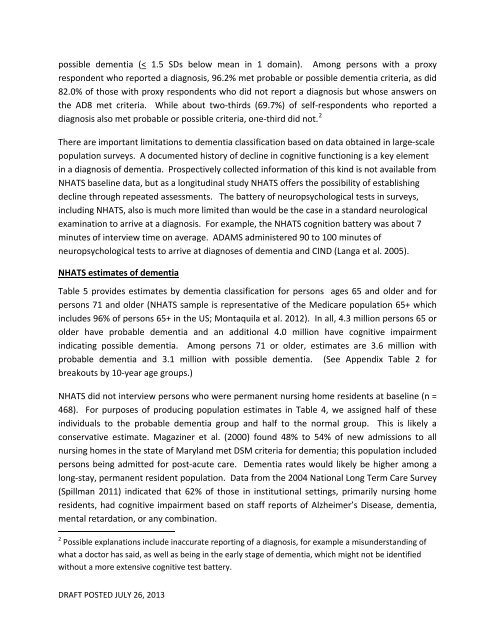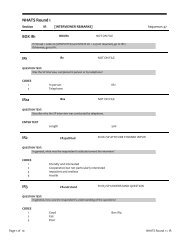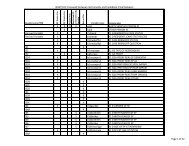Classification of Persons by Dementia Status in the ... - NHATS
Classification of Persons by Dementia Status in the ... - NHATS
Classification of Persons by Dementia Status in the ... - NHATS
You also want an ePaper? Increase the reach of your titles
YUMPU automatically turns print PDFs into web optimized ePapers that Google loves.
possible dementia (< 1.5 SDs below mean <strong>in</strong> 1 doma<strong>in</strong>). Among persons with a proxy<br />
respondent who reported a diagnosis, 96.2% met probable or possible dementia criteria, as did<br />
82.0% <strong>of</strong> those with proxy respondents who did not report a diagnosis but whose answers on<br />
<strong>the</strong> AD8 met criteria. While about two-thirds (69.7%) <strong>of</strong> self-respondents who reported a<br />
diagnosis also met probable or possible criteria, one-third did not. 2<br />
There are important limitations to dementia classification based on data obta<strong>in</strong>ed <strong>in</strong> large-scale<br />
population surveys. A documented history <strong>of</strong> decl<strong>in</strong>e <strong>in</strong> cognitive function<strong>in</strong>g is a key element<br />
<strong>in</strong> a diagnosis <strong>of</strong> dementia. Prospectively collected <strong>in</strong>formation <strong>of</strong> this k<strong>in</strong>d is not available from<br />
<strong>NHATS</strong> basel<strong>in</strong>e data, but as a longitud<strong>in</strong>al study <strong>NHATS</strong> <strong>of</strong>fers <strong>the</strong> possibility <strong>of</strong> establish<strong>in</strong>g<br />
decl<strong>in</strong>e through repeated assessments. The battery <strong>of</strong> neuropsychological tests <strong>in</strong> surveys,<br />
<strong>in</strong>clud<strong>in</strong>g <strong>NHATS</strong>, also is much more limited than would be <strong>the</strong> case <strong>in</strong> a standard neurological<br />
exam<strong>in</strong>ation to arrive at a diagnosis. For example, <strong>the</strong> <strong>NHATS</strong> cognition battery was about 7<br />
m<strong>in</strong>utes <strong>of</strong> <strong>in</strong>terview time on average. ADAMS adm<strong>in</strong>istered 90 to 100 m<strong>in</strong>utes <strong>of</strong><br />
neuropsychological tests to arrive at diagnoses <strong>of</strong> dementia and CIND (Langa et al. 2005).<br />
<strong>NHATS</strong> estimates <strong>of</strong> dementia<br />
Table 5 provides estimates <strong>by</strong> dementia classification for persons ages 65 and older and for<br />
persons 71 and older (<strong>NHATS</strong> sample is representative <strong>of</strong> <strong>the</strong> Medicare population 65+ which<br />
<strong>in</strong>cludes 96% <strong>of</strong> persons 65+ <strong>in</strong> <strong>the</strong> US; Montaquila et al. 2012). In all, 4.3 million persons 65 or<br />
older have probable dementia and an additional 4.0 million have cognitive impairment<br />
<strong>in</strong>dicat<strong>in</strong>g possible dementia. Among persons 71 or older, estimates are 3.6 million with<br />
probable dementia and 3.1 million with possible dementia. (See Appendix Table 2 for<br />
breakouts <strong>by</strong> 10-year age groups.)<br />
<strong>NHATS</strong> did not <strong>in</strong>terview persons who were permanent nurs<strong>in</strong>g home residents at basel<strong>in</strong>e (n =<br />
468). For purposes <strong>of</strong> produc<strong>in</strong>g population estimates <strong>in</strong> Table 4, we assigned half <strong>of</strong> <strong>the</strong>se<br />
<strong>in</strong>dividuals to <strong>the</strong> probable dementia group and half to <strong>the</strong> normal group. This is likely a<br />
conservative estimate. Magaz<strong>in</strong>er et al. (2000) found 48% to 54% <strong>of</strong> new admissions to all<br />
nurs<strong>in</strong>g homes <strong>in</strong> <strong>the</strong> state <strong>of</strong> Maryland met DSM criteria for dementia; this population <strong>in</strong>cluded<br />
persons be<strong>in</strong>g admitted for post-acute care. <strong>Dementia</strong> rates would likely be higher among a<br />
long-stay, permanent resident population. Data from <strong>the</strong> 2004 National Long Term Care Survey<br />
(Spillman 2011) <strong>in</strong>dicated that 62% <strong>of</strong> those <strong>in</strong> <strong>in</strong>stitutional sett<strong>in</strong>gs, primarily nurs<strong>in</strong>g home<br />
residents, had cognitive impairment based on staff reports <strong>of</strong> Alzheimer’s Disease, dementia,<br />
mental retardation, or any comb<strong>in</strong>ation.<br />
2 Possible explanations <strong>in</strong>clude <strong>in</strong>accurate report<strong>in</strong>g <strong>of</strong> a diagnosis, for example a misunderstand<strong>in</strong>g <strong>of</strong><br />
what a doctor has said, as well as be<strong>in</strong>g <strong>in</strong> <strong>the</strong> early stage <strong>of</strong> dementia, which might not be identified<br />
without a more extensive cognitive test battery.<br />
DRAFT POSTED JULY 26, 2013




